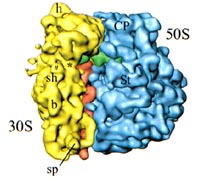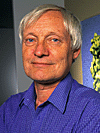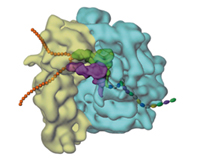 |
A
Model of the Ribosome Prepared by Cryo-Electron Microscopy The ribosome is a complex subcellular particle composed of protein and RNA. It is the site of protein synthesis, as described on pages 300-306 of the Dragonfly Book. In recent years, a number of laboratories have advanced the study of the ribosome to the point where we now have detailed atomic level models of the ribosome that explain many of the most important aspects of protein synthesis. One of the leaders of this research is Dr. Joachim Frank of the Wadsworth Institute, who kindly provided the image used in our textbook (shown at left). |
In the first few printings of our textbook, this image was described as having been prepared by neutron and X-ray diffraction. That was a mistake. While those are both useful techniques in the study of ribosomes, in fact this image was prepared by Cryo-electron microscopy:
Cryo-Electron Microscopy

